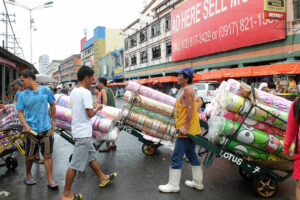WHILE Manila is the country’s capital city and serves as a metonym for the entire Philippines, a lot of the country’s activity is no longer centered there. While the presidential palace, Malacañang, still sits there, the country’s legislative bodies sit somewhere else. The arts and society perform and preen at nearby Pasay, and the country’s financial districts are in Makati, Taguig, and Ortigas (we can argue that Binondo serves as an informal one). Still, Manila has one card up its sleeve: Divisoria.
Rampa Manila 2, a fashion show that will be held on June 19 at the Bulwagang Antonio Villegas in Manila City Hall, will be a tribute to Divisoria, the colonial-era trading hub that still exists today. Thanks to its strategic location then and now near ports, roads, and trains, Divisoria is still a central market, where goods from manufacturers here and abroad land and are sold at almost-factory price.
One of the draws there are the textile markets, and in a way, the cloth trade in Divisoria makes it a fashion capital — at least in the eyes of Rampa Manila’s Creative Director, designer Bang Pineda. “Manila is the fashion capital, because of Divisoria,” he said in a press conference at Manila City Hall on April 11. He also said that this year’s theme would be “Texture, Textile and Technique.”
Rampa Manila 2 is a sequel to last year’s project, Rampa Manila, held last year near Manila Day (June 24). Participating designers last year included Puey Quiñones, Michael Leyva, Jo Rubio, Marlon Tuazon, and Albert Andrada. This year, the roster includes Anthony Ramirez, Neric Beltran, Marc Rancy, Val Taguba, Jhobes Estrella, and even new blood, namely: Dhenyze Guevara, Morissette Magalona, and Joanna Santos.
Mr. Pineda said, “Lahat kami started out as young designers, namimili ng tela sa Divisoria (we were all young designers who started out buying cloth in Divisoria).”
DIVISORIA’S PROBLEMSAt the same event, Manila Mayor Honey Lacuna-Pangan discussed problems Divisoria is having, and how the city could improve it.
“It’s so sad. Before kasi talaga, puntahan ang Divisoria for any needs; any kind of textile. During the past few years, nag-dwindle talaga iyong desire to go to Divisoria to avail textiles,” she said. She said that a lot of designers these days would rather get them somewhere else or import them directly.
Ms. Lacuna-Pangan and Department of Tourism, Culture, and Arts of Manila (DTCAM) Director Charlie Dungo also discussed projects that would have revived Remedios Circle as the fashion district of Manila (as it had been in the 1970s to the ’80s), but rents in the area were simply too high for the project to be feasible.
“It’s also the local government of Manila’s way to help iyong ating stakeholders doing business here. We’re trying to invite designers and future designers to go back to where it all started,” she said about these districts. “Ang ating ultimate goal is pataasin ang antas ng industriya ng fashion, hindi lang sa Maynila, kundi sa buong Pilipinas (our ultimate goal is to improve the level of the fashion industry, not just in Manila but the whole Philippines).” — Joseph L. Garcia
